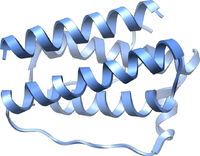
Photo from wikipedia
hronic Helicobacter pylori infection is a primary risk Cfactor for the development of gastric cancer, a leading cause of cancer-related death worldwide. H pylori initially colonizes the gastric antrum and,… Click to show full abstract
hronic Helicobacter pylori infection is a primary risk Cfactor for the development of gastric cancer, a leading cause of cancer-related death worldwide. H pylori initially colonizes the gastric antrum and, over time, can spread throughout gastric corpus causing oxyntic atrophy. In some human patients, the sustained chronic infection over many decades within the stomach eventually leads to the emergence of advanced gastric pathologies, including intestinal metaplasia, dysplasia, and cancer. How the sustained inflammatory response toward H pylori shapes tissue behavior independent of bacterial virulence factors, including induction of hyperplasia and changes in differentiation throughout the distal stomach, remains an important area of investigation. Defining the relevant cytokines, their direct cellular targets, and the cellular response are important steps to understanding early steps in disease progression. In this issue of Cellular and Molecular Gastroenterology and Hepatology, Ding et al explore how interleukin (IL)1b and interferon (IFN)-g influence tissue and cellular behaviors in the antrum. To accomplish this, they used mouse genetic tools to misexpress the 2 key cytokines associated with Helicobacter infection, specifically within the antrum using the gastrin promoter and recapitulated the phenomena in vitro using cell lines. The authors found that although both IL1b and IFN-g drive a hyperplastic phenotype within the antrum, they illicit divergent effects on endocrine cell differentiation. IFN-g increased G-cell numbers and serum gastrin levels, whereas IL1b suppressed overall endocrine cell differentiation, responsible for the suppressed serum gastrin levels. To connect these studies to previous exploration by this group, the authors investigated Hedgehog signaling, which has been implicated in the regulation of gastrin. The authors used mouse models of elevated SHH production, in the context of Helicobacter felis infection, to establish that Hedgehog signaling leads to decreased numbers of G-cells in the antrum and reduced serum gastrin levels. Interestingly, increasing SHH production significantly elevated the number of IL1bexpressing inflammatory cells, suggesting Hedgehog signaling might have direct and indirect effects on G-cell differentiation and gastrin levels. To continue to explore the relationship between SHH, IFN-g, and IL1b on gastrin, Ding et al used a gastrin-producing enteroendocrine mimicking GLUTag cell line. Consistent with their in vivo findings, IFN-g promoted gastrin secretion, whereas IL1b suppressed it in this cell line. This in vitro system confirms the direct effect of these cytokines on gastrin secretion, as confounding factors, such as gastric pH, are removed. Primary cilia are an important sensory organelle that plays an essential role in mammalian Hedgehog signaling. To explore whether the suppressive effects driven by IL1b and SHH on gastrin occur through the primary cilia, the
Journal Title: Cellular and Molecular Gastroenterology and Hepatology
Year Published: 2021
Link to full text (if available)
Share on Social Media: Sign Up to like & get
recommendations!